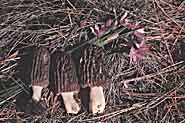 Mushroom Heaven
Mushroom Heaven
Northern Idaho hosts a multitude of mushrooms for the enjoyment of gourmands and/or photographers. Spring offers the succulent morel, considered to be the ne plus ultra of haute cuisine. Its flavorful flesh is so rich and savory when sautéed in butter that it can replace meat in a meal. It's also a wonderful foil for steaks.
Morels are widespread, growing lavishly on mountainside sites where old forest fires once burned. They are also to be found in aspen groves in a variety of conditions, from boggy to dry scab-rock.
Though morels are easy to spot and locate, a few look-alikes can create a problem. First-timer mushroom hunters should go with a knowledgeable friend. Finally, never eat morels raw: they must be cooked!
Late summer and autumn are the true seasons for 'shrooming. Meadows and forest floors in many areas become filled with hundreds of varieties of fungi in every size and shape, from tiny, exquisite toadstool colonies to jewel-toned mushrooms in nearly every shade of the spectrum: Purple, blue, red, yellow, white, tan and brown. Interspersing this mycological Oriental carpet are the corals crisp white icicle corals growing to the size of a bushel basket on the ends of old fallen cedar logs, and golden staghorn corals pushing up from the forest duff.
Many mushrooms grow from trees and tree roots, such as the lovely saffron/red and yellow Sulfur Shelf (Laetiporus sulphureus), or "Chicken of the Woods," a glorious sight and appropriately nicknamed treasure for the discriminating diner. Other great edibles are members of the Bolete family, the Chanterelles, Shaggy manes, many corals, some of the flammulinas the list of both edible and non-edible fungi is nearly endless, but edible or not, all are fascinating.
Priest Lake is in an area of astonishing mushroom habitat. Nearly every fall, Hill's Resort plays host to a weekend mushroom foray sponsored by the Spokane Mycological Society. The public is invited to participate (for a modest fee), gather mushrooms and bring them to a mass identification event overseen by experts. Call Hill's at 208/443-2551 for information.
Another educational opportunity will take place at the Bull River Ranger Station just across the border in Montana. An identification hike on the St. Paul Lake Trail is scheduled for Oct. 3. Local experts will point out edibles, medicinal, and visually or historically interesting fungi. It's free; call 406/847-2602 for information.
- Valle Novak